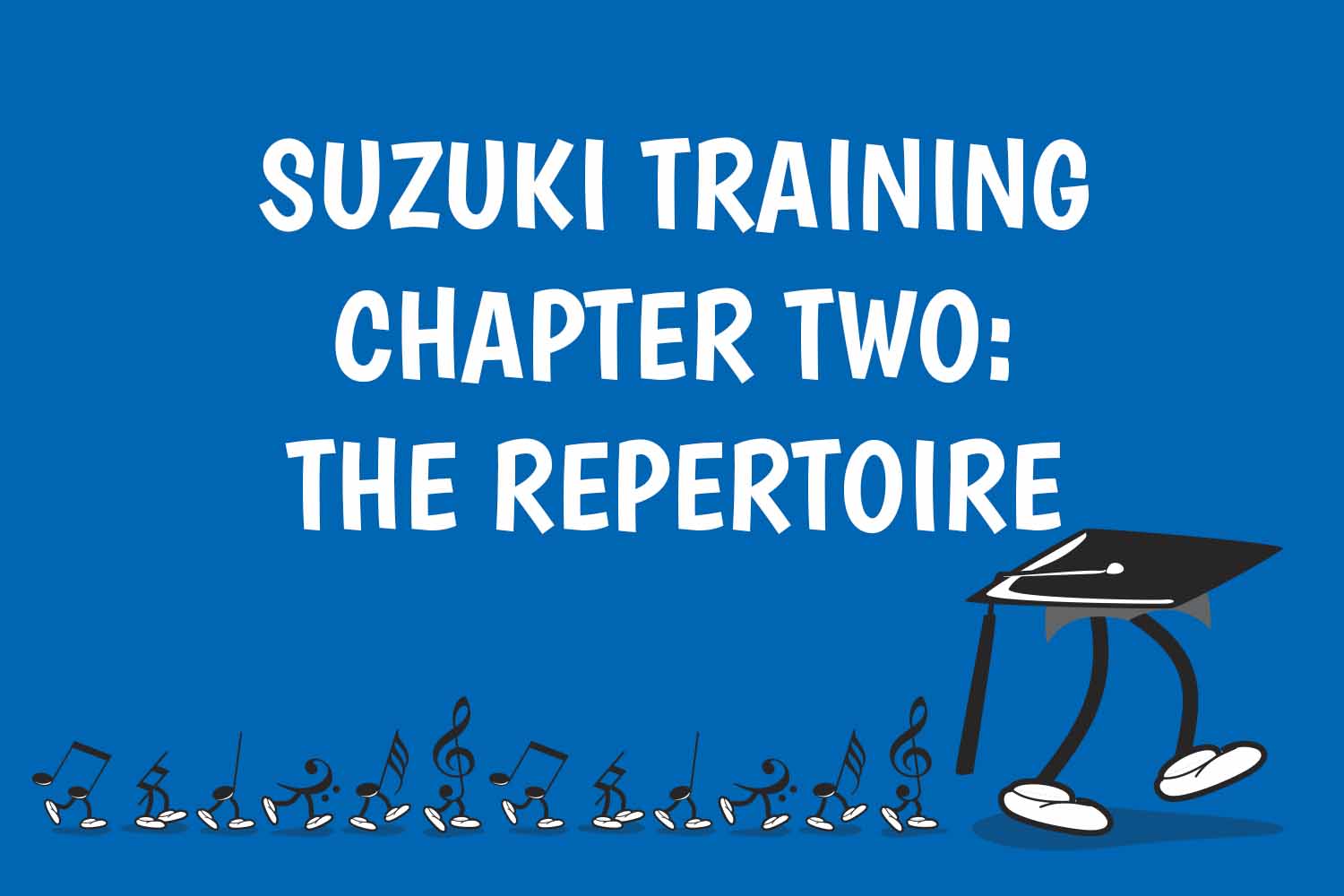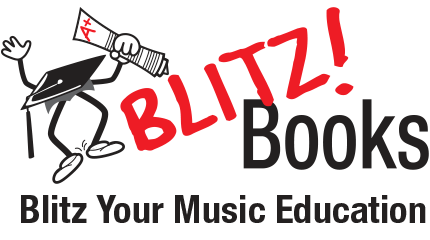Suzuki Training Chapter Two: The Repertoire

My seven Suzuki books arrived this morning! I couldn’t wait to sit down to play through the pieces.
Over the years I have inherited the odd Suzuki student here and there and I’ve seen pieces from the books, but I haven’t ever seen Book 1 nor had a look at the sequencing of pieces throughout.
I must admit, I did get a shock when I saw the very first piece in Book 1! It is a repeated semiquaver variation of Twinkle Twinkle Little Star – just like the first piece for the beginner violinists.
I am really not sure why this is the first piece for pianists. For violinists, I get it: it’s the ‘busy busy stop stop’ bowing pattern, and the piece covers first position only (and that’s about it for my knowledge of violin playing!). For pianists, it involves a difficult repeated note action, an interval of a 6th, and notes up high in the treble clef including a leger line (although given the Suzuki method revolves around rote learning and by ear playing, this last point is not so much an issue). I would think that for pianists, the first piece would involve BOTH hands and probably utilise a pentatonic tonality involving black notes. After all, these are the types of pieces that get young pianists really playing well, without worrying about reading the notes.
I am looking forward to further Suzuki training because I want to fully understand the philosophy behind the sequencing of all the pieces in the piano method. Being a traditional teacher AND a Yamaha trained teacher (working in solfege and ear training), I cannot imagine my beginner students playing pieces with Alberti bass in the left hand so early on in their careers.
Playing through the rest of the seven books, I found that I had played or taught almost every piece at some stage in my piano life. There is quite a mix of difficulty levels in each book, and as a result there is certainly no way to equate any one Suzuki book with any AMEB exam grade (which I think is a common error amongst traditional piano teachers) or in fact any piano syllabus I’m familiar with (ABRSM, Trinity, ANZCA).
The editions themselves are really well thought out in terms of fingering and articulation markings. The font is pleasant to read (but will students actually be reading it???) and there are excellent written-out versions of ornamentation.
The thing that struck me as I reached the end of Book Seven is that the furthest I had come in the history of music composition was 1945 – the year Bartok died. All of the Suzuki pieces are public domain, which means Suzuki students miss out on all the amazing music that has been composed in the last 70 years or so, as well as current music of course.
Perhaps it is up to the teacher to supplement with modern pieces? Will there be time in the lesson? Is this allowed? All this and more will become part of my knowledge base in the near future. Please leave a comment – I’d love to know your thoughts!

Suzuki makes sense for violinists who only have to read one note at a a time and where intonation is so critical. There is time for reading notation to catch up with aural training. For pianists, however, learning to read AND having a comfortable five finger position in each hand is imperative because notation for pianists is so much more complex and because the keyboard is basically designed around fingers – keys are finger width. For younger pianists this is even harder because there are no half sized pianos and so dealing with the interval of a sixth required in the first Suzuki book is unnecessarily difficult. What is appealing for all music students, including pianists, is the inclusion of aural learning. While pianists don’t have to worry as much about intonation as string players (the piano tuner takes care of this) learning can be enhanced by including activities in the lesson and in practice which encourage the student to play by ear. As the little Mexican girl says in the ad: “Why can’t we have both?” Part of a good piano lesson should be strictly devoted to reading from the page and a seperate part to playing chordal plus melody pieces by ear. In addition, once a piano student has learnt to read a piece well , listening to the same piece on youtube/etc should be encouraged for the extra information aural training cab give.
Absolutely agree with everything you’ve said, Alison! It is so true that we need a combination of rote/by ear learning and playing from notation. To limit students to one path or the other leaves gaps in musicality. Thanks so much for your great comments!
Hi Samantha, as a long term Suzuki teacher I can assure you we delve into many other composers right through all the books. They are our bones if you like. Love your comments. Carolyn Jarrett
Thanks Carolyn, that’s good to know!
There are 2 Suzuki students that come to me only to study theory; their teachers asked them to find themselves a teacher who can teach them theory, since she doesn’t teach theory. When we were learning Key Signatures, I found out that they also do not learn scales. So I taught them scales, as well. The Dad of one of the students is a beginner guitar player and he bought the Suzuki guitar book, wanting to go through it himself. He had a difficult time. It would be interesting to know the thought process behind the Suzuki method for instruments other than violin. Looking forward to your next article on this, Samantha!
Hi Samantha. All the best with your Suzuki training. The NZ exams for piano now utilise the Suzuki pieces especially at preliminary and early grades. I have had a look at the first 2 books but feel the pieces are too hard for prelim.
Do your exams use the Suzuki pieces, that is AMEB. Davina
Hi Davina, the AMEB Prelim and Grade 1 exams do contain a few pieces from Suzuki books 1 and 2 and even book 3! For example, Burgmuller’s Arabesque is on the Grade 1 AMEB syllabus. The sequencing is completely different and a bit baffling! I think the repertoire in Book 1 Suzuki seems very difficult for a stone cold beginner.
Hi Sam. Glad your inquiring mind is racing ahead. Re last 70 yrs, copyright costs I believe made Bartok the most recent composer in the published repertoire, but as Carolyn said, we do supplement. The order of repertoire allows for some plateau pieces after some challenging ones. These are gifts which students love learning by themselves, sometimes overnight! Loving your blogs! Xx
Thanks Erica! I would love to read about the philosophy behind the sequencing. Is there such a document?
I found this aspect particularly useful as a child! The difficulty followed by a rest, and feeling really clever that I learnt a piece so quickly!
Hi Samantha,
My daughter is learning Suzuki piano. And it was her piano teacher who introduced your books and website to us when she was learning the book 2 and we had been using your theory and sight reading books ever since. We do have loads of other non-Suzuki books at home, including Music Craft. I think it’s all up to the teacher and the individual student in terms of what repertoire could best help the student develop the skills and ability. As a parent with non musical background, I do love the repertoire structure of the Suzuki book though. It does give us a good starting point to educate ourselves too.
btw: My daughter loves your sight reading books.
Hi Nelson thanks for the lovely feedback! I do agree it is all up to the teacher to provide the broadest educational experience possible, and rather than restrict students to methods that were conceived almost 100 years ago in a different culture, to expose students to a wide variety of styles and skills.
Hi Samantha, my students love your sight reading Blitz books. Will there be a sight reading book 4?? or even book 5?? 🙂 Thanks!
Hi Cindy, no I’m afraid there won’t be a book 4 or 5… by that level of sight reading, the best thing is to just be reading standard piano repertoire, as much and as frequently as possible!
Hi, I know this is an old post, but I found your website through the 88 Creative Keys Webinar this morning and have enjoyed reading your blog posts!
I started piano lessons as a Suzuki student. I made it through 5 books in 6 years, then my teacher retired and I transferred to a non-Suzuki teacher. I won’t say “traditional,” because my second teacher was anything but traditional! The sequencing of repertoire is precisely why I don’t teach Suzuki piano myself. I played Bach Minuets as a 7-year-old; I played Clementi Sonatinas as an 8-year-old. My tiny hands were not prepared for any of that and my technique was awful. After 6 years of Suzuki piano, I spent the next 12 years undoing bad habits.
My understanding is that Suzuki violin is wonderfully sequenced for proper teaching of technique. But even so, the lack of 20th century repertoire is appalling. I took Suzuki violin lessons as a teenager and made it through 7 books in 4 years. I attended a Suzuki Institute one summer that was attended by students from all over the southeastern United States. One evening, there was a recital in which 2 professors performed the Ravel Sonata for Violin and Cello. It was amazing and I fell in love with Ravel! However, I was the only student who thought the performance was enjoyable. All that the other students could talk about was how much they “hated that 20th century crap.” I doubt that their teachers overtly taught them that 20th century music was bad, but the omission of 20th century repertoire spoke volumes to my peers.
If you ever come across a document outlining the justification for the sequence, I would love to read it.
Thanks for taking the time to write this, May. What an experience you’ve had with violin and piano. My understanding is that the Suzuki repertoire is all public domain which is why there is no ’20th century crap’!!! Isn’t it a shame.
Apparently Suzuki’s wife or sister approved the sequencing for piano. But I will keep searching for more information on that!